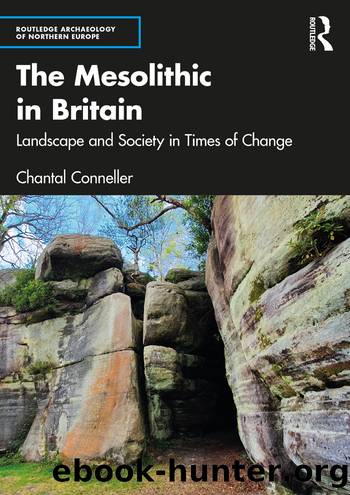The Mesolithic in Britain by Conneller Chantal;

Author:Conneller, Chantal; [Conneller, Chantal]
Language: eng
Format: epub
Tags: SOCIAL SCIENCE/Archaeology
Publisher: Taylor & Francis Group
Published: 2022-12-15T00:00:00+00:00
Vegetation and climate
Following the expansion of alder, and the arrival of the slow-spreading species ash and lime, vegetation across the country was varied. In the south and east, dense lime forests gradually replaced oak from around 6500 cal BC (Bennett 1989). Lime woods, with their dense canopies, support relatively little understorey growth which is important browse for deer. Fewer plant and animal resources may have made these areas less important foci for people (Spikins 1999). Mixed oak woodlands remained important over much of the rest of the country south of the Tay. These, apart from the densest, included understorey plants, which were attractive to animals, though some upland areas such as the North York Moors seem to have still been relative open with areas of birch woodland and grassland (Albert and Innes 2015), and the chalk landscapes of the Wolds too may have remained fairly open (Bush 1988). Further north, rich oak/hazel/birch woodlands flourished in the lowlands and pine woods in the uplands. In the far north, birch still held sway (Tipping 1994).
Within this broad picture, there was considerable variation, with soil types and altitude producing important differences in the makeup of woodlands. Alder, for instance, thrived in damp peat of river valleys (Figure 5.2) as sea-level rose and rivers backed up, but could not out-compete oak and elm in other areas unless disturbance was a factor (Bennett 1986). Chalk areas may have been less densely wooded (French et al. 2003). Ash thrived on calcareous soils, where it began to replace hazel (Bennett 1989), and pine lingered on the limestone of the Northern Pennines long after it had been outcompeted elsewhere in the country (Simmons 1996). Local factors are likely to have been significant, with beaver activity, local tree falls, lightning strike, disease and disturbance by humans (see below) creating unique combinations of woodland species that have no modern analogues. In these woodlands, clearings and paths would have been important. Brown (1997) highlights the importance of clearings created by tree falls in creating human spaces, and the tree throws themselves were often used as foci by the people who inhabited these spaces (see e.g. Bishop 2008). Whether created by tree fall or human burning practises (Simmons 1996) clearings became foci of human action (Davies et al. 2005), and paths created spaces through routinized action.
Figure 5.2 Alder carr at Rostherne Mere, Cheshire. This vegetation type became more common as alder expanded and wetlands increased (copyright Barry Taylor)
These woodlands provided plant food. Hazelnuts were still very common, though there have been some suggestions of a reduction following 6000 cal BC (Ashmore 2004). Of other plants, we have rare glimpses. Crab apples were eaten in the autumn. Lesser celandine bulbs were collected and roasted at Staosnaig and Northton (Bishop et al. 2013). Hawthorn berries were eaten in both England and Scotland (Bishop et al. 2013; Palmer 1999), and sloes are found on three sites in England and Wales. Elder and Dogwood seeds from Goldcliff (Bell 2007) may suggest these berries, too, were eaten. Vetch seeds can be roasted and eaten, and fat hen can be made into flour.
Download
This site does not store any files on its server. We only index and link to content provided by other sites. Please contact the content providers to delete copyright contents if any and email us, we'll remove relevant links or contents immediately.
How to Be a Bawse: A Guide to Conquering Life by Lilly Singh(7162)
Spare by Prince Harry The Duke of Sussex(4800)
Millionaire: The Philanderer, Gambler, and Duelist Who Invented Modern Finance by Janet Gleeson(4113)
Machine Learning at Scale with H2O by Gregory Keys | David Whiting(3653)
Harry Potter 02 & The Chamber Of Secrets (Illustrated) by J.K. Rowling(3559)
Never by Ken Follett(3545)
The Heroin Diaries by Nikki Sixx(3326)
Urban Outlaw by Magnus Walker(3250)
Harry Potter and the Prisoner of Azkaban (Book 3) by J. K. Rowling(3119)
Japanese Design by Patricia J. Graham(3005)
Fairy Tale by Stephen King(2961)
The Man Who Died Twice by Richard Osman(2818)
The Club by A.L. Brooks(2753)
Stacked Decks by The Rotenberg Collection(2696)
Will by Will Smith(2589)
Harry Potter and the Deathly Hallows (7) by J.K. Rowling(2554)
Churchill by Paul Johnson(2372)
The Chimp Paradox by Peters Dr Steve(2233)
Borders by unknow(2121)
